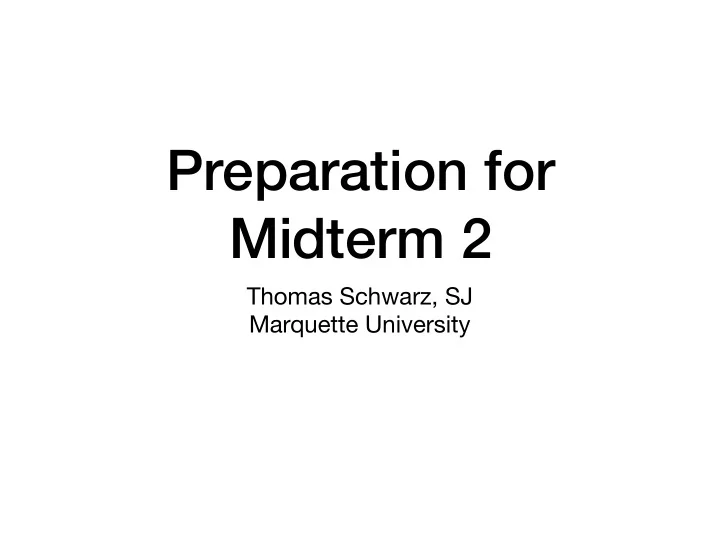

Preparation for Midterm 2 Thomas Schwarz, SJ Marquette University
String Processing • String processing patterns • Substituting in strings • Use a dictionary to contain substitutions
File Processing • File processing patterns • Count the frequency for the beginning letter of a word • Create a counter object • Open file with “with” • Use a for loop to go through every line • Use split and a for loop to pass through every word • Canonicalize the word • Add word to counter • Return the tablef
File Processing import collections def count_start_word(filename): ctr = collections.Counter() with open(filename, encoding="latin-1") as infile: for line in infile: for word in line.split(): word = word.lower().strip(“[&(*,.;:'\"'`?!") if word: ##we could have stripped ##the word to nothing ctr[word[0]] += 1 return ctr.most_common()
Test Yourself • Alter the preceding code to find the frequencies of the last letters in word
Test Yourself • You just need to change the counter to count word[-1]. def count_end_word(filename): ctr = collections.Counter() with open(filename, encoding="latin-1") as infile: for line in infile: for word in line.split(): word = word.lower().strip("[&(*,.;:'\"'`?!") if word: ##we could have stripped the word to nothing ctr[word[-1]] += 1 return ctr.most_common()
Memoization • A more complicated example: • How many stamps are needed to make various postages • Assume we have three types of stamps: ones, fours, and fives • To lick 27 cents, we can: • five 5c + 2 1c stamps: total of 7 stamps • four 5c, one 4c and 3 1c stamps: total of 8 stamps • three 5c and three 4c stamps: total of six stamps
Memoization • Given an amount n we want to calculate the minimum number of stamps needed • An inane method: Try out all possibilities def inane(n): best_seen = n for ones in range(n+1): for fours in range(n+1): for fives in range(n+1): if ones*1+fours*4+fives*5 == n: if ones+fours+fives < best_seen: best_seen = ones+fours+fives return best_seen
Memoization • Why is it inane? • It takes iterations to try out all possibilities n × n × n
Memoization • A better way? • Given an amount n , we can try out the best ways to lick n -5, n -4, and n -1, corresponding to deciding to first lick a five cent, a four cent, and a one cent stamp • Find the best among those three possibilities and add one to it, because we already licked one stamp if n = 0 0 • 1 + lick ( n − 5) if n ≥ 5 lick ( n ) = min( ) 1 + lick ( n − 4) if n ≥ 4 1 + lick ( n − 1) if n ≥ 1
Memoization • This gives immediately a nice recursive implementation def lick(amount): Just some special base cases if amount == 0: return 0 if amount < 4: return amount if amount == 4: return 1 if amount == 5: return 1 return min([lick(amount-1), lick(amount-4), lick(amount-5)])+1
Memoization • But this recursive version is very slow • That is because the same value link(x) can be calculated many times • So we put the intermediate results into a dictionary to remember them • This is called memoization
Memoization • Memoization: • Maintains a cache of intermediate results • If the function is called on a value: • We first check whether the value is in the cache • Otherwise: we calculate it and put it into the cache
Memoization lick_dictionary = {0:0, 1:1, 2:2, 3:3, 4:1, 5:1} def mlick(amount): if amount in lick_dictionary: return lick_dictionary[amount] else: result = min([mlick(amount-1), mlick(amount-4), mlick(amount-5)])+1 lick_dictionary[amount] = result return result
Recommend
More recommend